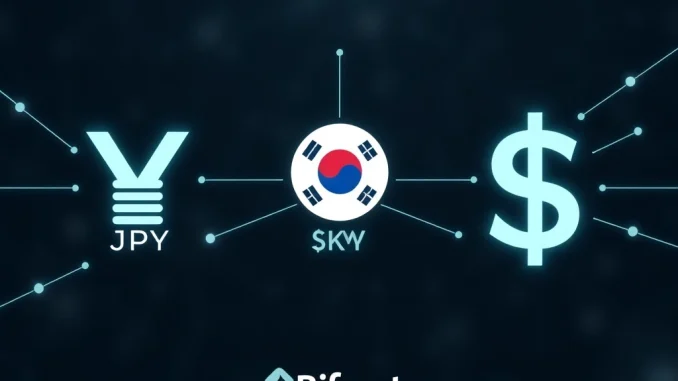
Big news from the world of blockchain infrastructure! The team behind the Bifrost Network, a leading L1 cross-chain platform, is making moves that suggest a significant expansion into the stablecoin space. Recent trademark filings reveal their interest in launching stablecoins pegged to major fiat currencies. This development is particularly interesting for anyone watching the evolution of cross-chain finance and the growing role of stable digital assets.
Bifrost Network’s Trademark Move: What Happened?
According to data from the Korea Intellectual Property Rights Information Service (KIPRIS), PiLab Technology, the South Korean firm operating the Bifrost Network, has officially filed trademark applications related to stablecoins. These filings specifically cover the names MJPY, MKRW, and MUSD.
This action signals a clear intention to potentially develop and launch stablecoins tied to the Japanese Yen (JPY), South Korean Won (KRW), and the US Dollar (USD). While trademark filings don’t guarantee a product launch, they are a necessary step in protecting brand identity for future ventures. It suggests PiLab Technology is exploring or planning to introduce these specific stable assets into the market, likely within the Bifrost ecosystem.
Understanding Stablecoins and Their Role
Stablecoins are a type of cryptocurrency designed to minimize price volatility. They achieve this stability by typically being pegged to a reserve asset, most commonly a fiat currency like the US Dollar, but also potentially commodities or algorithmic mechanisms. They play a crucial role in the crypto market by:
- Providing a stable store of value during market volatility.
- Facilitating easier trading between cryptocurrencies and fiat without needing to leave the crypto ecosystem.
- Enabling various DeFi (Decentralized Finance) applications like lending, borrowing, and yield farming with reduced price risk.
- Acting as a medium of exchange for payments.
For a cross-chain network like Bifrost, which aims to connect different blockchains, stablecoins could be particularly valuable for enabling seamless and stable value transfer across diverse protocols.
What Do MJPY, MKRW, and MUSD Signify for Bifrost?
The choice of JPY, KRW, and USD for these potential stablecoins points to specific strategic considerations by PiLab Technology. The US Dollar (MUSD) is the dominant currency in the global stablecoin market, making a USD-pegged stablecoin almost essential for broad adoption and integration into the wider crypto landscape.
However, the inclusion of MJPY (Japanese Yen) and MKRW (South Korean Won) is noteworthy. It suggests a focus on expanding Bifrost’s reach and utility in the Asian markets, particularly Japan and South Korea, where PiLab Technology is based. Having stablecoins pegged to local fiat could:
- Improve accessibility for users in these regions.
- Potentially comply better with future regional regulations.
- Facilitate local currency on/off-ramps.
- Support specific dApps or services tailored for these markets on the Bifrost Network.
This multi-currency approach could position Bifrost to serve a diverse, international user base more effectively.
The Potential Impact for PiLab Technology and Bifrost Network
Filing these crypto trademarks is more than just a formality; it’s a statement of intent. It indicates that PiLab Technology sees stablecoins as a key component of Bifrost’s future. Launching their own stablecoins could bring several benefits:
| Potential Benefit | Explanation |
|---|---|
| Ecosystem Growth | Native stablecoins can attract users and developers, fostering DeFi activity and transaction volume on Bifrost. |
| Cross-Chain Utility | Facilitate stable value transfer between connected blockchains, enhancing Bifrost’s core function. |
| Revenue Streams | Potential for revenue through transaction fees, interest on reserves, or partnerships. |
| Brand Recognition | Establishing Bifrost as a provider of essential crypto infrastructure like stablecoins. |
However, launching and maintaining stablecoins also comes with significant challenges, including regulatory compliance, managing reserves transparently, and competing with established players in a crowded market.
The Broader Crypto Trademarks Landscape
Trademark filings are becoming increasingly common in the crypto space as companies mature and seek to protect their intellectual property and brand identity. These filings cover everything from exchange names and wallet services to specific coin names and blockchain protocols. For investors and users, observing these filings can sometimes offer early clues about a company’s strategic direction and future product pipeline, just as these filings by PiLab Technology suggest Bifrost’s stablecoin ambitions.
What’s Next for Bifrost and These Stablecoins?
While the trademark filings are confirmed, the specific details regarding the launch, underlying mechanisms (e.g., fiat-backed, crypto-backed, algorithmic), and integration of MJPY, MKRW, and MUSD into the Bifrost Network remain to be seen. The next steps would likely involve formal announcements from PiLab Technology, technical development, and potentially regulatory approvals depending on the jurisdictions and the stablecoin structure.
This move positions Bifrost to potentially become a more versatile platform for cross-chain financial activities, offering users stable ways to hold and transfer value across different networks and in different key currencies.
In Summary
PiLab Technology’s filing of trademarks for MJPY, MKRW, and MUSD is a strong indicator that the Bifrost Network is exploring or planning a significant push into the stablecoin market. By targeting major global currencies like the USD and key regional currencies like the JPY and KRW, Bifrost appears to be positioning itself for broader international adoption and enhanced cross-chain financial utility. While challenges lie ahead, this development signals a potential expansion that could make Bifrost a more central player in the evolving landscape of decentralized finance and cross-chain interoperability.



